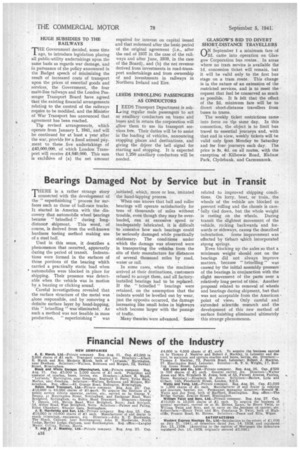Bearings Damaged Not by Service but In Transit
Page 18

If you've noticed an error in this article please click here to report it so we can fix it.
THERE is a rather strange story I connected with the development of the " superfinishing " process for surfaces such as those of ball-race tracks. It started in America with the discovery that automobile wheel bearings became " brinelled during longdistance shipment. This word, of course, is derived from the well-known hardness testing method making use of a steel ball.
Used in this sense, it describes a phenomenon that occurred, apparently during the period of transit. Indentations were formed in the surfaces of those portions of the bearing which carried a practically static load when • automobiles were blocked in place for shipping. Their presence was detectable when the vehicle was in motion by a buzzing or clicking sound. .
Careful investigations revealed that
a the surface structure of the metal was alone responsible, and by removing a definite surface layer by hand-lapping. this " brinelling " was eliminated. As such a method was not feasible in mass
production, " superfinishing " was initiated, which, more or less, imitated the hand-lapping process.
When one knows that ball and roller bearings will operate satisfactorily for tens of thousands of miles without trouble, even though they may be overloaded, run at excessive speed or inadequately lubricated, it is difficult to 'conceive how such bearings could be seriously damaged while practically stationary. The conditions under which the damage was observed were in transporting the vehicles from the site of their manufacture for distances of several thousand miles by road, water or rail.
In some cases, when the machines arrived at their destinations, customers refused to accept them, and all factoryinstalled bearings had to be replaced. If the " brinelled " bearings were retained, on the assumption that the indents would be levelled out by wear, just the opposite occurred, the damage increasing like small holes in highways which become larger with the passage of traffic.
Many theories were advanced. Some related to improved shipping conditions. On lorry, boat, or train, the wheels of the vehicle are blocked to prevent rolling and the chassis is carefully tied down, but the whole weight is resting on the wheels. During transit the slightest movement of the vehicle, rocking backwards and forwards or sideways, causes the described indentation. Some improvement was effected by tiebars which incorporated strong springs.
Even blocking up the axles so that a minimum weight should rest on the bearings did not always improve matters, because " brinelling " was caused by the initial assembly pressure of the bearings in conjunction with the slight movement of the parts over a relatively long period of time. Another proposal related to removal of wheels and bearings during shipment, but that was not acceptable from the American point of view. Only careful and extended scientific research and the development of this new method of surface finishing eliminated ultimately this strange phenomenon.




















































